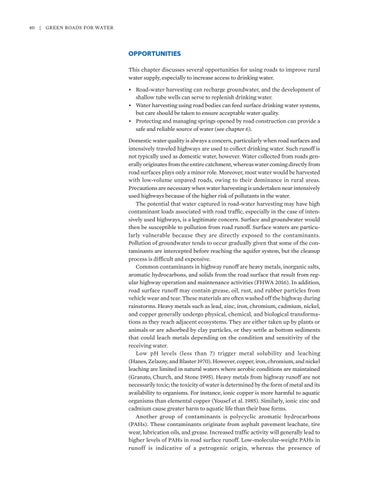40 | Green Roads for Water
OPPORTUNITIES This chapter discusses several opportunities for using roads to improve rural water supply, especially to increase access to drinking water. • Road-water harvesting can recharge groundwater, and the development of shallow tube wells can serve to replenish drinking water. • Water harvesting using road bodies can feed surface drinking water systems, but care should be taken to ensure acceptable water quality. • Protecting and managing springs opened by road construction can provide a safe and reliable source of water (see chapter 6). Domestic water quality is always a concern, particularly when road surfaces and intensively traveled highways are used to collect drinking water. Such runoff is not typically used as domestic water, however. Water collected from roads generally originates from the entire catchment, whereas water coming directly from road surfaces plays only a minor role. Moreover, most water would be harvested with low-volume unpaved roads, owing to their dominance in rural areas. Precautions are necessary when water harvesting is undertaken near intensively used highways because of the higher risk of pollutants in the water. The potential that water captured in road-water harvesting may have high contaminant loads associated with road traffic, especially in the case of intensively used highways, is a legitimate concern. Surface and groundwater would then be susceptible to pollution from road runoff. Surface waters are particularly vulnerable because they are directly exposed to the contaminants. Pollution of groundwater tends to occur gradually given that some of the contaminants are intercepted before reaching the aquifer system, but the cleanup process is difficult and expensive. Common contaminants in highway runoff are heavy metals, inorganic salts, aromatic hydrocarbons, and solids from the road surface that result from regular highway operation and maintenance activities (FHWA 2016). In addition, road surface runoff may contain grease, oil, rust, and rubber particles from vehicle wear and tear. These materials are often washed off the highway during rainstorms. Heavy metals such as lead, zinc, iron, chromium, cadmium, nickel, and copper generally undergo physical, chemical, and biological transformations as they reach adjacent ecosystems. They are either taken up by plants or animals or are adsorbed by clay particles, or they settle as bottom sediments that could leach metals depending on the condition and sensitivity of the receiving water. Low pH levels (less than 7) trigger metal solubility and leaching (Hanes, Zelazny, and Blaster 1970). However, copper, iron, chromium, and nickel leaching are limited in natural waters where aerobic conditions are maintained (Granato, Church, and Stone 1995). Heavy metals from highway runoff are not necessarily toxic; the toxicity of water is determined by the form of metal and its availability to organisms. For instance, ionic copper is more harmful to aquatic organisms than elemental copper (Yousef et al. 1985). Similarly, ionic zinc and cadmium cause greater harm to aquatic life than their base forms. Another group of contaminants is polycyclic aromatic hydrocarbons (PAHs). These contaminants originate from asphalt pavement leachate, tire wear, lubrication oils, and grease. Increased traffic activity will generally lead to higher levels of PAHs in road surface runoff. Low-molecular-weight PAHs in runoff is indicative of a petrogenic origin, whereas the presence of







































